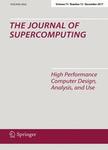版权所有:内蒙古大学图书馆 技术提供:维普资讯• 智图
内蒙古自治区呼和浩特市赛罕区大学西街235号 邮编: 010021

作者机构:Shiraz Univ Technol Dept Comp Engn & Informat Technol Shiraz Iran
出 版 物:《JOURNAL OF SUPERCOMPUTING》 (超高速计算杂志)
年 卷 期:2013年第65卷第3期
页 面:1243-1263页
核心收录:
学科分类:0808[工学-电气工程] 08[工学] 0812[工学-计算机科学与技术(可授工学、理学学位)]
主 题:Software performance engineering Performance models Optimization methods Object deployment Statistical methods
摘 要:The quantitative performance evaluation of different deployments of distributed software objects over computational nodes is one of the main activities during the early stages of the design phase and should be supported by automated tools. The important design decision is to finding the optimal placement of objects, from the performance viewpoint, for different input workloads. Each deployment of objects may impose two kinds of delay on the overall performance of the software: first, the communicational delay due to the remote invocations among distributed objects and second, the computational delay due to the resource sharing by two or more concurrently executing object invocations. The object deployment problem can be formulated as an optimization problem to find the optimal deployment for which the total delay is minimal. In this paper an analytical model for delay prediction of object deployments considering the input workload of the software is presented. This model applies the object-oriented load metrics such as object population and object utilization to estimate the total amount of delay corresponding to a given object deployment. To achieve this, a novel method, called delay propagation, is proposed to compute the amount of delay corresponding to each method invocation which affects the overall response time of the software. In order to verify the proposed analytical delay predictor model, a statistical regression-based method is used. Moreover, by comparing the proposed method with the existing deployment optimization methods, which apply the Layered Queueing Networks to evaluate the performance of each deployment in the search space, a significant improvement in efficiency is observed due to the fast evaluation of each deployment instance in the search space.